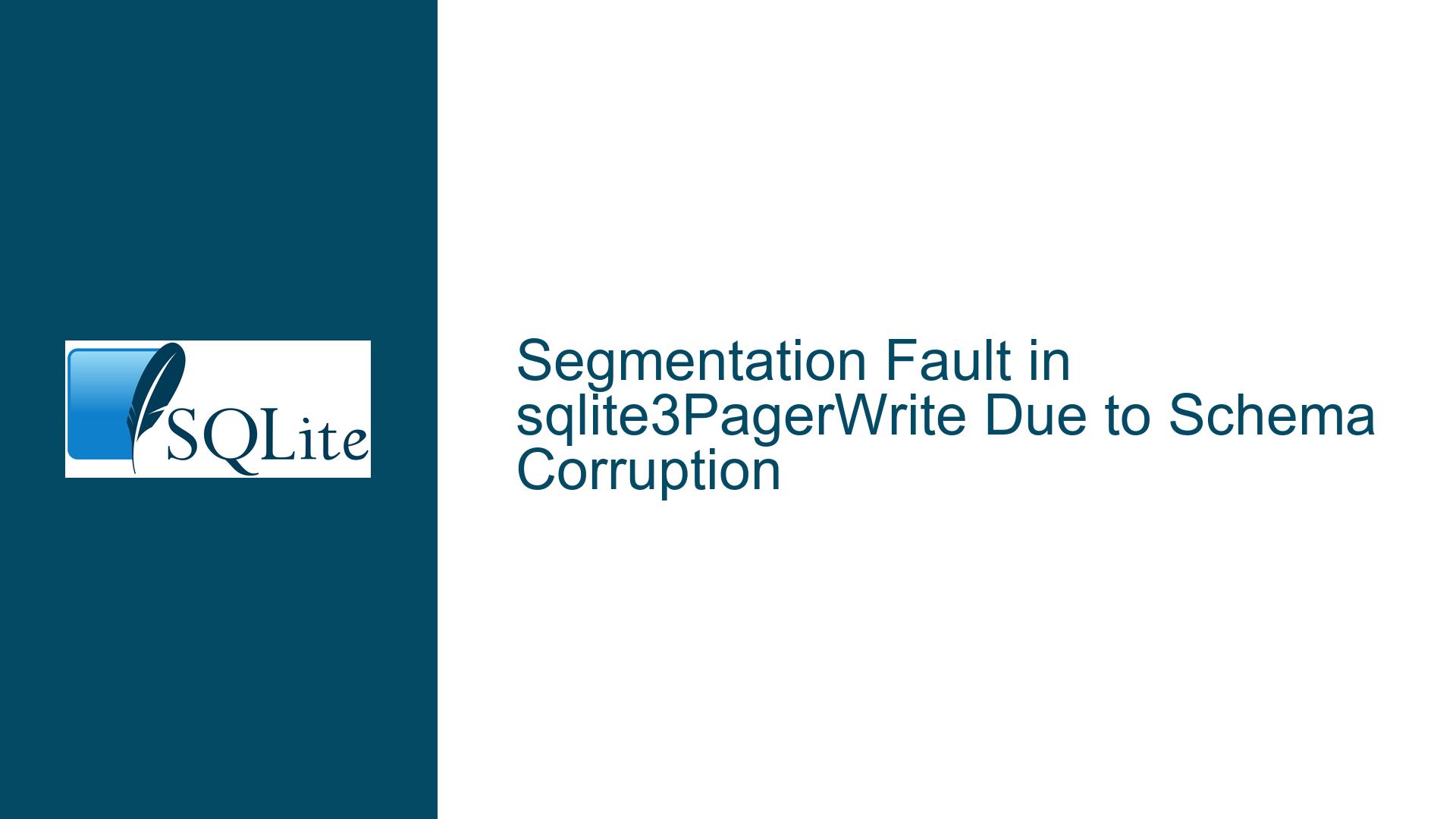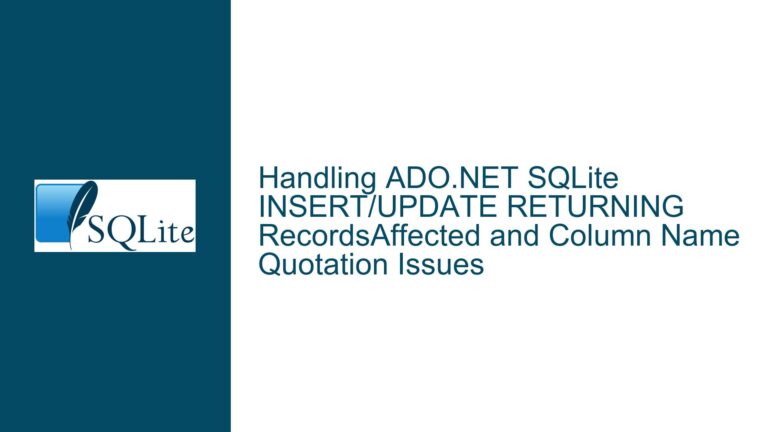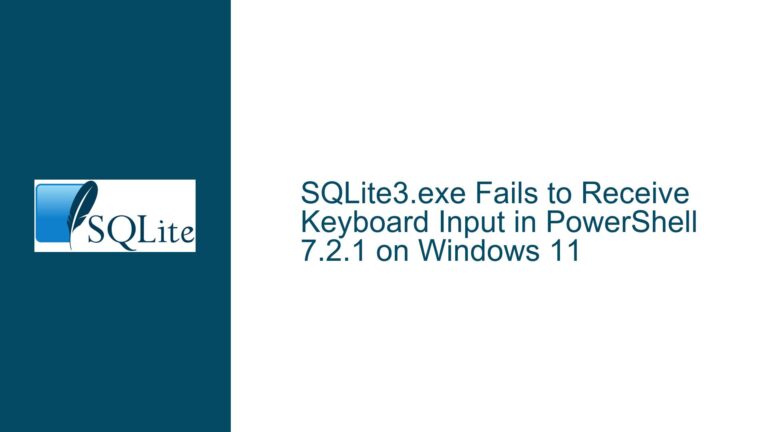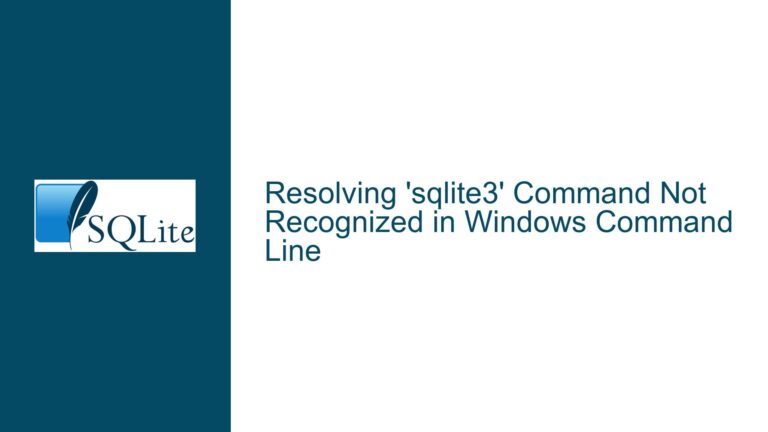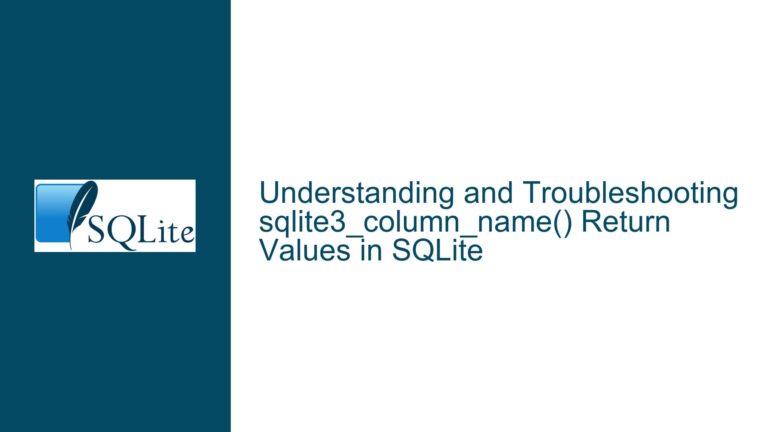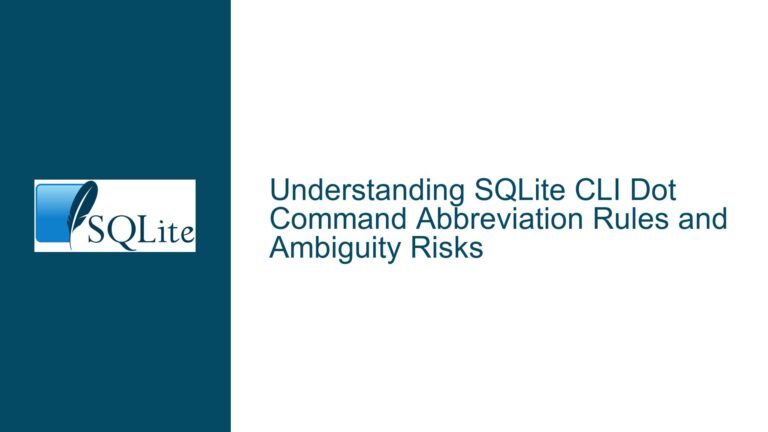Segmentation Fault in sqlite3PagerWrite Due to Schema Corruption
Issue Overview: Segmentation Fault in sqlite3PagerWrite During Schema Manipulation
The core issue revolves around a segmentation fault (SEGV) occurring in the sqlite3PagerWrite function within SQLite. This fault is triggered under specific conditions involving schema manipulation, particularly when the PRAGMA writable_schema=ON setting is enabled. The fault manifests during the execution of a series of SQL statements that modify the database schema and insert data into a table. The segmentation fault is detected by AddressSanitizer (ASAN), which reports a memory access violation at address 0x000000000000, indicating a null pointer dereference or an invalid memory access.
The fault occurs in the context of a complex schema definition involving generated columns, unique constraints, and a WITHOUT ROWID table. The schema manipulation includes updating the sqlite_schema table directly, which is a risky operation that can lead to database corruption if not handled carefully. The fault is specifically triggered when attempting to write to the pager, which is responsible for managing the database file’s pages in memory and ensuring data integrity during write operations.
The issue is exacerbated by a recent change in SQLite (check-in 19e56291a7344c7a) that allows Data Manipulation Language (DML) statements to proceed even after corruption is detected when PRAGMA writable_schema=ON is enabled. This change, while intended to provide flexibility in schema manipulation, inadvertently allows the database to reach an inconsistent state, leading to the segmentation fault.
Possible Causes: Schema Corruption and Invalid Memory Access
The segmentation fault in sqlite3PagerWrite can be attributed to several interrelated factors, primarily revolving around schema corruption and invalid memory access. The first and most significant factor is the use of PRAGMA writable_schema=ON, which allows direct modification of the sqlite_schema table. This pragma is a powerful tool that can be used to alter the database schema in ways that are not typically allowed, but it also bypasses many of SQLite’s built-in safeguards, making it easy to corrupt the database if used improperly.
In this case, the schema corruption occurs when the UPDATE sqlite_schema SET rootpage=(SELECT rootpage FROM sqlite_schema WHERE name='t1') statement is executed. This statement modifies the rootpage field of the sqlite_schema table, which is a critical part of SQLite’s internal data structure. The rootpage field points to the root page of the B-tree that stores the table’s data. By setting the rootpage field to the same value as another table, the database is left in an inconsistent state, as the B-tree structure is no longer valid.
The second factor contributing to the segmentation fault is the use of generated columns and unique constraints in the table definition. Generated columns are computed based on other columns in the table, and they introduce additional complexity to the schema. When combined with unique constraints and the WITHOUT ROWID option, the schema becomes even more complex, increasing the likelihood of encountering edge cases that can lead to corruption.
The third factor is the recent change in SQLite (check-in 19e56291a7344c7a) that allows DML statements to continue executing even after corruption is detected when PRAGMA writable_schema=ON is enabled. This change was intended to provide more flexibility in schema manipulation, but it also means that the database can continue to operate in an inconsistent state, leading to unpredictable behavior. In this case, the segmentation fault occurs because the database attempts to write to an invalid memory location, resulting in a crash.
Troubleshooting Steps, Solutions & Fixes: Preventing Schema Corruption and Ensuring Data Integrity
To address the segmentation fault in sqlite3PagerWrite, it is essential to prevent schema corruption and ensure data integrity. The following steps outline the necessary actions to troubleshoot and resolve the issue:
1. Avoid Using PRAGMA writable_schema=ON Unless Absolutely Necessary
The use of PRAGMA writable_schema=ON should be avoided unless absolutely necessary. This pragma bypasses many of SQLite’s built-in safeguards, making it easy to corrupt the database if used improperly. If schema modifications are required, consider using standard SQL statements such as ALTER TABLE or CREATE INDEX instead of directly modifying the sqlite_schema table.
2. Validate Schema Changes Before Applying Them
Before applying any schema changes, especially those involving direct modifications to the sqlite_schema table, it is crucial to validate the changes to ensure they will not lead to corruption. This can be done by performing the changes in a test environment and verifying that the database remains consistent. Additionally, consider using SQLite’s built-in integrity check (PRAGMA integrity_check) to verify the database’s integrity after making schema changes.
3. Apply the Fix from Check-in 4df301c8610c4c36
The issue has been fixed in SQLite by check-in 4df301c8610c4c36. This fix addresses the problem by preventing DML statements from continuing after corruption is detected when PRAGMA writable_schema=ON is enabled. To resolve the issue, update to a version of SQLite that includes this fix. This will ensure that the database does not continue to operate in an inconsistent state, preventing the segmentation fault from occurring.
4. Use Generated Columns and Unique Constraints Carefully
Generated columns and unique constraints introduce additional complexity to the schema, increasing the likelihood of encountering edge cases that can lead to corruption. When using these features, ensure that the schema is well-designed and that the generated columns and constraints do not conflict with each other. Additionally, consider testing the schema thoroughly to identify and address any potential issues before deploying it to a production environment.
5. Monitor and Address Memory Access Violations
The segmentation fault in sqlite3PagerWrite is caused by an invalid memory access, which can be detected using tools such as AddressSanitizer (ASAN). To prevent similar issues in the future, consider using ASAN or similar tools to monitor memory access and identify potential violations. Additionally, ensure that the database is not left in an inconsistent state, as this can lead to invalid memory accesses and other unpredictable behavior.
6. Implement Robust Error Handling and Recovery Mechanisms
To minimize the impact of schema corruption and other issues, implement robust error handling and recovery mechanisms in your application. This includes handling errors gracefully, providing meaningful error messages, and implementing recovery procedures to restore the database to a consistent state in the event of corruption. Additionally, consider using transactions to ensure that changes are applied atomically and can be rolled back if an error occurs.
7. Regularly Backup the Database
Regularly backing up the database is essential to ensure that data can be recovered in the event of corruption or other issues. Consider implementing a backup strategy that includes both full and incremental backups, and ensure that backups are stored securely and can be restored quickly if needed. Additionally, consider using SQLite’s built-in backup API to automate the backup process and ensure that backups are consistent.
8. Stay Informed About SQLite Updates and Best Practices
SQLite is actively developed, and new updates and best practices are regularly released. To ensure that your database remains secure and reliable, stay informed about the latest updates and best practices. This includes monitoring the SQLite mailing list, reading the release notes for new versions, and participating in the SQLite community to share knowledge and learn from others.
By following these steps, you can prevent schema corruption, ensure data integrity, and avoid segmentation faults and other issues in SQLite. Additionally, by staying informed about the latest updates and best practices, you can ensure that your database remains secure and reliable over time.
